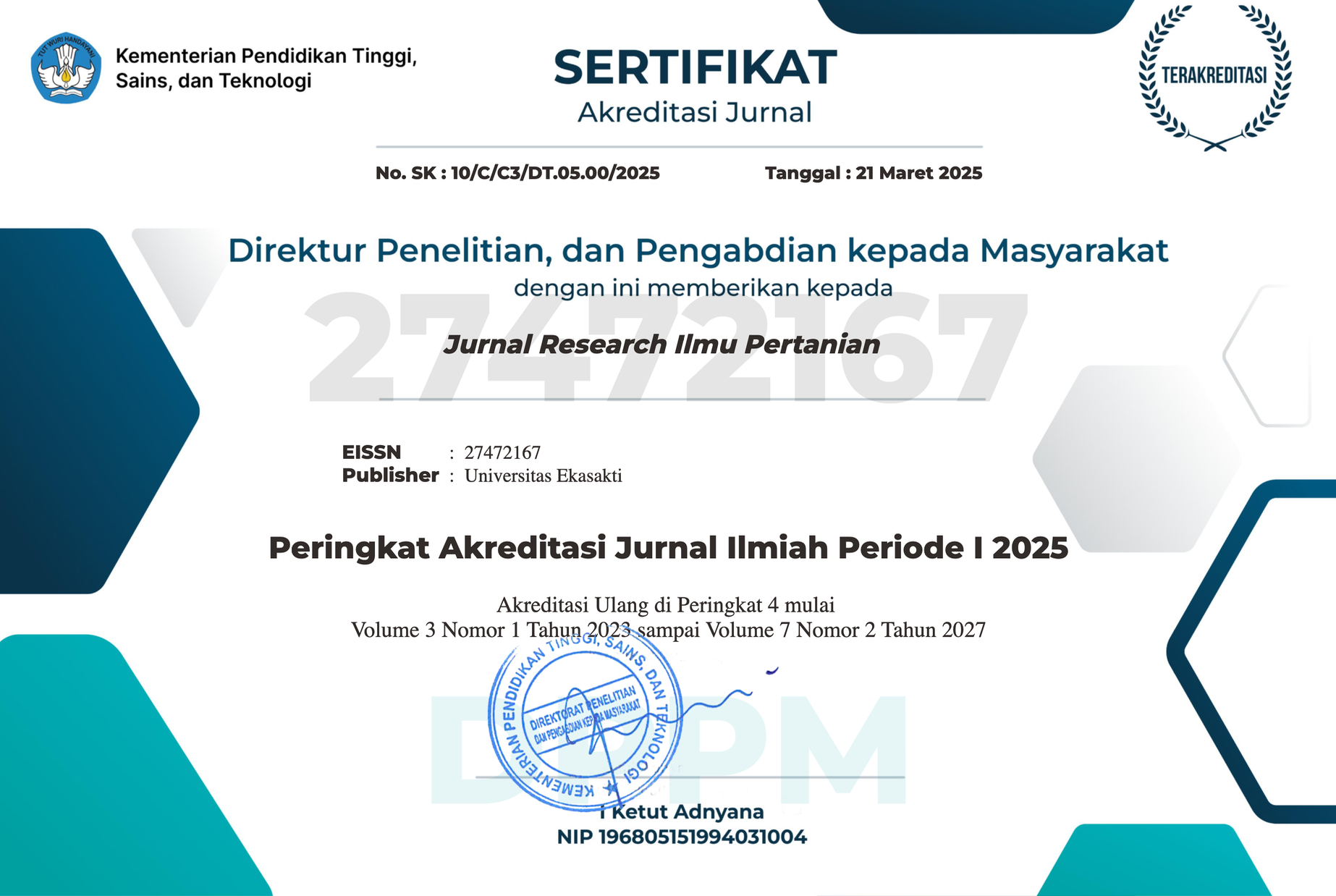Respon Pertumbuhan Bibit Vanili (Vanilla planifolia) Akibat Pemberian Bokashi Kotoran Ayam
DOI:
https://doi.org/10.31933/04xt7h52Keywords:
Vanilla Seeds, Bokashi, Chicken Manure, GrowthAbstract
This research has been carried out on Jalan Kandih Raya, Olo Village, Nanggalo District, Padang City, West Sumatra. The research was carried out from January to April 2020. This study aimed to obtain the best Vanilla planifolia (Vanilla planifolia) growth response due to the provision of Chicken Manure Bokashi. The design used was a Randomized Block Design (RAK), with 6 treatments and 4 groups, so that there were 24 trials, in each experiment consisting of 4 plants, the total plants used were 96 plants. As treatment are various doses of Bokashi Chicken Manure, namely: Treatment A = 65 g/seed, B = 75 g/seed, C = 85 g/seed, D = 95 g/seed, E = 105 g/seed, F = 115 g /seedling. The results of the data were analyzed statistically by means of variance (F test). If Fcount > Ftable 5%, then to find out the influential treatments, a further test was carried out with Duncan's New Multiple Range Test (DNMRT). increase, increase in seed length (cm), increase in shoot diameter (mm), increase in the number of leaves (strands), plant fresh weight (g), and plant dry weight (g). Based on the results of the study, it was found that offering several doses of chicken manure bokashi gave different effects on the increase in plant length and weight, but not significantly on the increase in tuna diameter, leaf number, and plant weight. Giving bokashi chicken manure 115 g/seed is the best dose for vanilla seedling growth
Downloads
References
Anjarsari, I. R. D. 2007. Pengaruh Kombinasi Pupuk P dan Kompos Terhadap Pertumbuhan Tanaman Teh. Dikutip dari http://pustaka.Unpad.ac.id. Diakses pada tanggal 08 juni 2020.
Gardner, F.P., R.B. Pearce, dan R.L. Mitchell. 1991. Physiology of Crop Plants (Fisiologi Tanaman Budidaya, alih bahasa oleh Herawati Susilo). University Of Indonesia Press. Jakarta.
Guritno, B. dan S. M. Sitompul. 1995. Analisis Pertumbuhan Tanaman. Universitas Gajah Mada. Yogyakarta.
Hadipoentyanti, E., A. Ruhanayat, dan L. Udarno. 2013 Teknologi Unggulan Vanili : Budidaya dan Pascapanen Pendukung Varietas Unggul. Pusat Penelitian dan Pengembangan Perkebunan Bogor. Bogor.
Jumin, H. S. 2002. Ekologi Tanaman Suatu Pendekatan Fisiologis. Rajawali Press. Jakarta.
Lawani, M. 1991. Panili, Budidaya dan Penanganan Pasca Panen. Penerbit Kanisius. Yogyakarta.
Leiwakabessy. 1998, Kesuburan Tanah. Jurusan Ilmu Tanah. Fakultas Pertanian IPB. Bogor.
Lumbanraja, P. 2007. Pengaruh Pemberian Pupuk Kandang Sapi dan Jenis Mulsa Terhadap Kapasitas Pegang Air Tanah dan Pertumbuhan Tanaman Kedelai (Glycine max L).
Musnamar, E.I. 2009. Pupuk Organik Cair dan Padat, Pembuatan, Aplikasi. Penebar Swadaya. Jakarta.
Novizan. 2005. Petunjuk Pemupukan Yang Efektif. Agromedia Pustaka. Jakarta.
Pusat Data dan Sistem Informasi Kementrian Pertanian Indonesia. 2018. Tanaman Perkebunan.
Rismanto, A. E. Vatika, R, Juniardi, dan S. Oktavia. 2020. Pembuatan Bokashi Kotoran Ayam. Universitas Ekasakti. Padang.
Sari, H. P., Warnita, W., & Dwipa, I. (2019). Pemberian Rizobakteri dan Coumarin pada Pertumbuhan dan Pembentukan Umbi Tanaman Kentang (Solanum tuberosum L). Jurnal Agronomi Indonesia (JAI), 47(2), 188–195. https://doi.org/10.24831/jai.v47i2.21608
Suntoro, W. A. 2003. Peranan Bahan Organik dalam Kesuburan Tanah dan Upaya Pengelolaannya. Universitas Sebelas Maret Surakarta. 36 hal
Susetya, D. 2013. Sukses Bertanam Vanili Usaha Jeli Sang Pengharum Makanan. Pustaka Baru Press. Yogyakarta
Downloads
Published
Issue
Section
License
Copyright (c) 2024 Rafi Juniardi, Yulfi Desi, Yonny Arita Taher (Author)

This work is licensed under a Creative Commons Attribution 4.0 International License.











